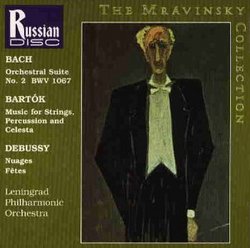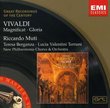| All Artists: Johann Sebastian Bach, Claude Debussy, Yevgeny Mravinsky, Leningrad Philharmonic Orchestra, Béla Bartók (Composer) Title: The Mravinsky Collection - Bach: Suite No. 2 for Orchestra / Bartok: Music for Strings, Percussion and Celesta / Debussy: Nocturnes for Orchestra Members Wishing: 0 Total Copies: 0 Label: Russian Disc Release Date: 8/23/1994 Genre: Classical Styles: Forms & Genres, Suites, Historical Periods, Baroque (c.1600-1750), Modern, 20th, & 21st Century, Symphonies Number of Discs: 1 SwapaCD Credits: 1 UPC: 748871116726 |
Search - Johann Sebastian Bach, Claude Debussy, Yevgeny Mravinsky :: The Mravinsky Collection - Bach: Suite No. 2 for Orchestra / Bartok: Music for Strings, Percussion and Celesta / Debussy: Nocturnes for Orchestra
CD DetailsSimilar CDs
|
CD ReviewsMravinsky Rarities Fred Granlund | Los Angeles, CA USA | 07/26/2008 (4 out of 5 stars) "Yevgeny Mravinsky achieved international cult status even during his lifetime--a fair accomplishment for a conductor who spent his whole career behind the Iron Curtain, rarely made recordings and almost never toured outside the Soviet bloc. He was appointed principle conductor of the Leningrad (now St. Petersburg) Philharmonic in 1938--just two years after Eugene Ormandy took over the Philadelphia Orchestra from Leopold Stokowski--and held the post for an astounding 50 years, until his death in 1988. The last of a generation of conductors who terrorized their players and demanded near-impossible standards of execution, he often spent months rehearsing a work they had performed many times, adjusting every nuance and fine-tuning every detail. The progress made during those year can be judged by comparing their rare but revealing recordings: for example, the premiere recording of the Shostakovich 5th Symphony (1938, available on this site in a very inexpensive 4-CD set with early recordings of Tchaikovsky, et al), in which a tentative, understaffed orchestra responds with feverish intensity to every bar of the music, and those famous early-60s Tchaikovsky Symphonies, where the same intensity is now joined by breath-taking precision and virtuosity.
The present program is taken from among the dozens of "live" recordings to be issued by various labels over the years in an attempt to supplement the small number of "official" Mravinsky recordings. Made between 1960 and 1970, they document conductor and orchestra in music not usually associated with them, performed with the same obsessive attention to detail we hear in the Russian Romantic works that made up their core repertoire. Not that attention to detail is always a good thing: the Bach Suite, doubtless performed from an inauthentic Russian edition, is played without a trace of historically-informed style, missing the double-dotted rhythms in the Overture, observing very few repeats and sporting some lumbering tempi for the dance movements. But the uniformity of phrasing and and dynamics is a wonder of technical accomplishment, and the music benefits from the rare clarity and balance. The unnamed flute soloist is of like mind with the conductor, joining in what is essentially a 19th- Century view of the work. With Bartok and Debussy, we have works that definitely respond to that trademark intensity and ear for detail. The Bartok is as wild and flamboyant as the more familiar 1965 performance recorded in Moscow (and released on EMI LP in the 60s), the playing a bit tighter, at least until the final movement, taken even faster than the composer's very optimistic metronome setting, and the drama even more gripping. The two Debussy Nocturnes fare even better, with careful dynamic shading and transparent balances. The recordings aren't stereo, but are clear and distortion-free (except for a trace at the climax of "Fetes"). Only in the Bartok is the lack of directionality a hindrance, and that is partially mitigated by the second orchestra being heard from a slightly greater distance, preserving a bit of the intended spacial relationship. But that keeps it from getting a 5-star review. Recommended for all except the audiofiles." |


 Track Listings (13) - Disc #1
Track Listings (13) - Disc #1

